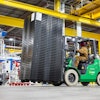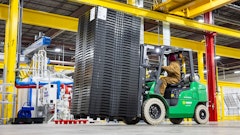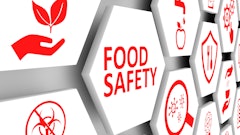
Extreme weather is disrupting food supply chains across the globe, prompting producers and distributors to rethink disaster preparedness. A resilient-by-design approach — one that integrates climate risk into operations — is no longer optional.
Recent events illustrate the stakes. Hurricane Milton pummeled Georgia’s agriculture sector, dropped over 30 inches of rain across North Carolina, and delayed shipments for weeks. In Spain, unrelenting heat drove olive oil prices to record highs. And in early 2025, a UN-backed study found that heatwaves, floods, and droughts disrupted food production and supply chains in 20 Latin American and Caribbean countries.
These events are not isolated. The United States recorded a historic number of billion-dollar weather and climate disasters in both 2023 and 2024. The World Meteorological Organization now projects record or near-record global temperatures through 2029, creating more conditions ripe for disruption. Food supply chains, often reliant on tight delivery schedules and just-in-time logistics, are especially exposed to delays caused by these events.
Why weather risk is now an operational issue
For food and beverage companies, weather is no longer just a seasonal concern; it’s a direct operational and financial risk. Disruptions now come with regulatory scrutiny, spoilage, reputational damage, and logistical chaos.
Flooded roads, impassable highways, and port closures can force last-minute rerouting. That translates into longer delivery times, increased fuel costs, and missed service level agreements. A cold storage unit knocked offline by heat or flood can spoil entire shipments. Even slight temperature deviations can trigger costly recalls and loss of trust. Regulatory violations related to cold chain logistics, especially from the Food and Drug Administration or the Occupational Safety and Health Administration, may result in steep fines or even suspension of licenses.
The financial, operational, and reputational risks are converging. That's why a resilient-by-design strategy built on decision-grade weather data is gaining urgency.
Leaders in the food logistics space are increasingly recognizing that integrated, context-rich data isn’t just useful; it’s essential for staying compliant, maintaining operational efficiency, and protecting margins in the face of growing weather-related disruptions.
4 essentials of a resilient-by-design approach
1. Advanced weather modeling
Integrating advanced weather modeling into transportation management systems (TMS) allows operators to anticipate and act. Traditional TMS platforms optimize routes and freight, but without advanced weather modeling, they cannot anticipate disruptions and respond proactively. Weather intelligence fills this gap with predictive climate models, hyperlocal forecasts, and operational alerts.
That combination allows companies to:
- Evaluate supplier and distribution center locations based on long-term climate exposure.
- Receive granular route-level forecasts to adjust in real time.
- Respond proactively with tailored actions — not just weather warnings.
One Midwest food shipper used this approach to sidestep three blizzards along the I-90 corridor between Cleveland, Ohio, and Buffalo, N.Y. Alerts about shifting winds and plummeting temperatures came 15 days in advance, enabling the company to reroute water shipments to facilities where they wouldn’t freeze, saving $30,000 per load.
The same shipper uses weather intelligence to monitor “pinch points” like mountain passes and tunnels that are prone to closures. This has allowed them to maintain delivery timelines to major restaurant chains with zero tolerance for delays.
2. AI and supply chain mapping
AI-powered mapping helps companies understand how their supply chain is connected and where the vulnerabilities lie. When paired with seasonal or long-range weather outlooks, this visibility becomes actionable.
For instance, if forecasts point to an above-average hurricane season, AI integrated into existing systems can flag which suppliers, transportation corridors, or cold storage facilities are most likely to be affected. With that insight, companies can shift inventory, adjust shipping schedules, or line up backup suppliers located outside high-risk zones weeks or even months in advance.
During Hurricane Milton, a major distributor of fresh poultry in the Southeast failed to anticipate how feeder routes into two processing plants in southern Georgia would be cut off by storm-related flooding. Without integrated supply chain mapping tied to forecast data, trucks were already en-route when roads became impassable. With more than 100,000 pounds of poultry spoiled in trailers that couldn’t reach cold storage, the distributor was forced to emergency sourcing and triggering out-of-stocks for several regional grocery chains.
This kind of disruption isn’t inevitable, but without visibility it’s hard to prevent. AI-driven supply chain mapping, layered with weather intelligence, gives companies the foresight and flexibility to protect both product and reputation.
3. Early warning systems
Timely alerts are critical to avoid costly missteps. Accurate and granular early warnings give operators enough lead time to implement preventive strategies before weather becomes a crisis.
Whether it’s halting outbound loads, reassigning drivers, or switching suppliers, having time to make the call matters as response delays multiply downstream impacts. One missed shipment can mean hundreds of delayed deliveries and tens of thousands of spoiled goods.
As climate models grow more sophisticated, the window for action is opening wider for companies positioned to act on advanced insights.
4. Real-time course correction
Flexibility is a core feature of supply chain weather resilience. That means having up-to-date data and alternate routes, suppliers, and backup storage identified ahead of time.
For example, a wildfire in California could halt vegetable shipments, or a hurricane could knock out key citrus producers in Florida or Texas. Being able to adjust plans on the fly based on real-time insights separates disruption from disaster.
Staying ahead of disruption
As climate patterns shift and extreme weather becomes more common, food logistics operators are finding value in planning ahead rather than reacting after the facts.
Building weather resilience isn’t just about avoiding delays; it’s also about creating flexible, informed systems that can adapt as conditions change.
With integrated, decision-grade weather data, companies gain the clarity to make smarter choices, such as rerouting shipments, adjusting schedules, and protecting product quality even when weather adds complexity.
In today’s marketplace, staying ahead of disruption means having the decision-grade weather data at the right time and the confidence in the forecast to act on it.



















